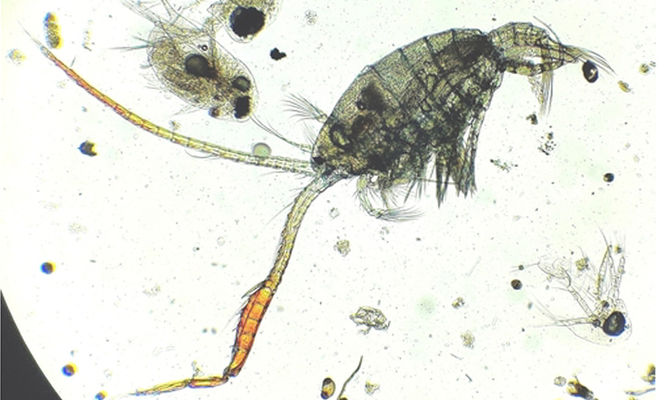Scientific Name: Eudiaptomus gracilis Sars G.O., 1863
Synonym: Diaptomus gracilis (Currently unaccepted)
English Name: Tiny Watercritter
Local/Bangla Name: Diaptomus (ডায়াপটোমাস)
Classification:
Kingdom: Animalia
Phylum: Arthropoda
Class: Copepoda
Order: Calanoida
Family: Diaptomidae
Description:
The organism has a cylindrical body, with symmetrical antennules and biramous antennae. The female metasome lacks a dorsal process. In the male, the fifth legs are asymmetrical, with the five-jointed right leg being larger than the three-jointed left leg. The second segment of the right leg has both endopod and exopod. The first segment of the exopod forms an antero-lateral projection on its outer angle and towards its inner angle. The second segment bears a lateral spine at its anterior part, and the terminal segment of the claw is strong and sickle-shaped, armored with small needle-like processes along its inner margin. In the male, the right endopod of the fifth leg is longer and stouter compared to other species. The short left fifth leg reaches about halfway up to the tip of the right leg. The first segment has a short spine, and the broader second segment has both exo- and endopod. The exopod bears numerous hairs on its inner margin and a distally outgrowth that terminates into a curved spine, while the terminally pointed endopod bears a few hairy processes on its inner margin near its tip and a lateral spine. Sometimes, the endopod also bears two spines at its distal end and hairs in between them. The organism is transparent white in color. Measurements include a total length of 1.03-1.12 mm for the male, with a breadth of 0.28-0.35 mm, metasome measuring 0.75-0.82 mm, and urosome measuring 0.28-0.32 mm. For the female, total length ranges from 1.15-1.25 mm, with a breadth of 0.32-0.38 mm, metasome measuring 0.90-0.98 mm, and urosome measuring 0.25-0.30 mm (Bhouiyan and Asmat, 1992).
The life cycle includes male and female individuals, copulation, fertilization, and development. Larger individuals of both sexes mate more frequently. Females produce their eggs in a single egg sac, which is carried at the median part. Development involves larval and post-larval stages. Female stages V and VI and copepodid stages I-V exhibit diel changes in vertical distribution, whereas male stages V and VI show significant vertical migration. However, all stages exhibit significant clumping in the vertical plane. The adults are free-living.
Habitat & Distribution in Bangladesh:
Commonly found in rivers in Bangladesh, such as the Halda River.
Environment:
Freshwater
References:
Ahmed ATA, Kabir SMH, Ahmad M, Rahman AKA, Haque EU, Ahmed ZU, Begum ZNT, Hassan MA, Khondker M (eds.) (2008) Encyclopedia of Flora and Fauna of Bangladesh, Vol. 18. Part II. Arthropoda: Crustacea. Asiatic Society of Bangladesh, Dhaka, 226 pp






